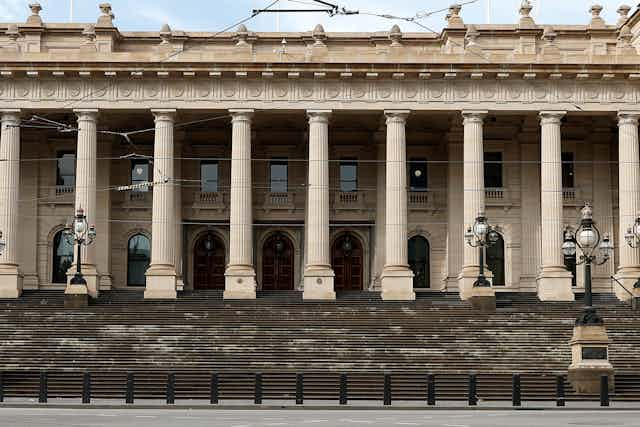There has been much more counting for the Victorian upper house since Saturday night, when under 30% had been counted in most of the eight regions. Five members are elected per region for a total of 40 seats, with the quota for each region at one-sixth of the vote or 16.7%.
The upper house still uses the group voting ticket (GVT) system, which allows parties to order the preferences of everyone who votes for that party above the line. On these artificial 100% preference flows, parties can win using preference spirals from very low vote shares.
Read more: How Victorian Labor's failure on upper house electoral reform undermines democracy
At least 60% of enrolled voters have now been counted in all regions, with a final turnout likely around 90%. Additional votes are more likely to skew left. I expect final results for the upper house by the week after next, when buttons are pressed to electronically distribute preferences.
The ABC’s summary page for the upper house, based on using its upper house calculator, has Labor on 15 of the 40 seats, the Coalition 15, the Greens three, Legalise Cannabis three and one each for Animal Justice, the Shooters, Labour DLP and One Nation. This calculator assumes all votes are above the line; about 10% were below the line.
If these results are the final results, the left parties (Labor, Greens, Legalise Cannabis and Animal Justice) would have 22 of the 40 upper house seats, to 18 for the right. Labor would need both the Greens and Legalise Cannabis to pass legislation opposed by the right. I will look at these results region by region.
In Northeastern Metro (71% counted), Labor has 2.06 quotas, the Liberals 1.86 and the Greens 0.62. After preferences, the Greens win with 1.02 quotas, and their margin would be higher with below the line (BTL) votes factored in.
In Northern Metro (60% counted), Labor has 2.06 quotas, the Liberals 1.13, the Greens 1.10, the Victorian Socialists 0.30, the DLP 0.28 and Fiona Patten 0.23. Left-wing preferences flow to Patten, not the Socialists. Former Labor MP Adem Somyurek, the DLP’s lead candidate, defeats Patten with 1.05 quotas, but Patten would be doing better on BTL votes.
In Southeastern Metro (62% counted), Labor has 2.39 quotas, the Liberals 1.65, the Greens 0.41, and Legalise Cannabis 0.30. On other left preferences, Legalise Cannabis beats both Labor and the Greens, then wins this seat on Labor and Greens preferences. The Liberals are just ahead of the Liberal Democrats for the final seat with 1.01 quotas, thought this lead would be wider with BTLs.
In Southern Metro (68% counted), the Liberals have 2.24 quotas, Labor 1.80 and the Greens 0.90. Both the Greens and Labor reach quota on other left preferences, with Labor well ahead of a Sustainable Australia preference spiral to claim the last seat with 1.08 quotas.
In Western Metro (64% counted), Labor has 2.25 quotas, the Liberals 1.53, the Greens 0.45, the DLP 0.31, Legalise Cannabis 0.25 and the Socialists 0.21. Legalise Cannabis surpasses the Greens on Scoialists and other left preferences and wins on Greens preferences, with the Liberals beating the DLP for the final seat.
In Eastern Victoria (69% counted), the Coalition has 2.22 quotas, Labor 1.60, the Greens 0.47 and Legalise Cannabis 0.24. Labor wins a second seat on Greens preferences, while the Shooters win from 0.18 initial quotas by preference spiral.
In Northern Victoria (71% counted), the Coalition has 2.20 quotas, Labor 1.68, the Greens 0.40, the Shooters 0.31, Legalise Cannabis 0.27 and One Nation 0.22. Both One Nation and Animal Justice (0.09 quotas) surpass Labor to win seats by preference spiral.
In Western Victoria (72% counted), Labor has 2.15 quotas, the Coalition 1.67, the Greens 0.49 and Legalise Cannabis 0.29. On other left preferences, Legalise Cannabis moves 0.05 quotas ahead of the Greens, then wins the final seat on Greens preferences, with the Coalition winning a second seat.
Lower house: Labor could win 56 out of 88 seats
For the lower house, the ABC is currently calling 51 of the 88 seats for Labor, 26 for the Coalition and four Greens, with seven still undecided. Labor is leading in four of the seven undecided seats, and behind by just five votes in Pakenham.
Late counting is favouring Labor, so they could win these five seats and get 56 total in the lower house, an increase of one on their 2018 landslide. The Coalition is likely to win Mornington and Narracan when this deferred election is held.
US Georgia Senate runoff next Wednesday AEDT
The United States November 8 midterm elections are not quite finished, as the Georgia Senate contest has gone to a runoff next Tuesday, with polls closing at 11am Wednesday AEDT.
At the November 8 election, Democrat Raphael Warnock won 49.4% and Republican Herschel Walker 48.5%. A Libertarian, with 2.1%, prevented a majority for either candidate, and so the runoff. Polls for the runoff suggest a close contest.
Democrats currently lead the Senate by 50-49. Even if Warnock loses, they will still control the Senate on Vice President Kamala Harris’ casting vote. But this election is important because Democrats face a very difficult Senate map in the 2024 elections.
Of the 33 Senate seats up for election in 2024, 23 are Democrat-held and just ten Republican-held. Democrat-held seats include three states – West Virginia, Montana and Ohio – that Donald Trump won easily in both 2016 and 2020. Democrats need to win Georgia next week to have a realistic chance of keeping the Senate after the 2024 elections.
Republicans likely won the House of Representatives on November 8 by a margin of 222-213 over Democrats, the exact reverse of Democrats’ 222-213 majority after the 2020 elections. Republicans lead the overall House popular vote by 50.7-47.8 according to the Cook Political Report.

